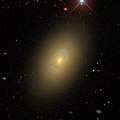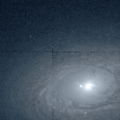NGC 4138
NGC 4138 is the New General Catalogue identifier for a lenticular galaxy in the northern constellation of Canes Venatici. Located around 52 million light years from Earth,[3] it spans some 2.1 × 1.3[1] arc minutes and has an apparent visual magnitude of 11.3.[4] The morphological classification of NGC 4138 is SA0+(r), indicating it lacks a bar formation and has tightly wound spiral arms with a ring-like structure around the nucleus.[5] It has no nearby companion galaxies.[2]
| NGC 4138 | |
|---|---|
 Image of NGC 4138 taken by the Hubble Space Telescope in green light (547 nm). | |
| Observation data (J2000 epoch) | |
| Constellation | Canes Venatici |
| Right ascension | 12h 09m 29.788s[1] |
| Declination | +43° 41′ 07.14″[1] |
| Redshift | 0.002962[2] |
| Helio radial velocity | 872[3] |
| Distance | 52 Mly (16.0 Mpc)[3] |
| Apparent magnitude (V) | 11.32[4] |
| Apparent magnitude (B) | 12.16[4] |
| Characteristics | |
| Type | SA0+(r)[5] |
| Apparent size (V) | 2.087′ × 1.252′[1] |
| Other designations | |
| 2MASX J12092978+4341071, LEDA 38643, UGC 7139, UZC J120929.9+434107, Z 215-37.[6] | |
This is a Seyfert 1.9 galaxy with an active galactic nucleus, having radio emissions detected in its nuclear region. Two radio sources have been detected, with the eastern component being the brighter at 1.0 mJy while the fainter source is emitting 0.75 mJy. This radiation is most likely coming from jets of energetic material being ejected by a central black hole.[7]
In 1996 it was revealed that this galaxy has a counter-rotating disk; around 20% of the stars in the galaxy are rotating in the opposite direction from the other 80%.[2] The neutral and ionized gas in this galaxy are rotating in the same direction as the counter-rotating disk, and the stars in this group are generally younger than the main stellar population. This disk may have formed as the result of a merger with a gas-rich dwarf galaxy some four billion years ago. Simulations indicate that the counter-rotation of this disk is acting to suppress spiral arm features in the galaxy as a whole. The young, star-forming ring structure is likely the result of collisions between gas clouds rotating in the opposite directions.[8]
Gallery
 NGC 4138 (SDSS DR14)
NGC 4138 (SDSS DR14) NGC 4138 (HST)
NGC 4138 (HST)
References
- Skrutskie, M. F.; et al. (February 2006), "The Two Micron All Sky Survey (2MASS)", Astrophysical Journal, 131 (2): 1163–1183, Bibcode:2006AJ....131.1163S, doi:10.1086/498708.
- Jore, Katherine P.; et al. (August 1996), "A Counter-Rotating Disk in the Normal SA Galaxy NGC 4138", Astronomical Journal, 112: 438, Bibcode:1996AJ....112..438J, doi:10.1086/118027.
- Tully, R. Brent; et al. (October 2013), "Cosmicflows-2: The Data", The Astronomical Journal, 146 (4): 25, arXiv:1307.7213, Bibcode:2013AJ....146...86T, doi:10.1088/0004-6256/146/4/86, 86.
- Gil de Paz, Armando; et al. (2007), "The GALEX Ultraviolet Atlas of Nearby Galaxies", Astrophysical Journal Supplement Series, 173 (2): 185–255, arXiv:astro-ph/0606440, Bibcode:2007ApJS..173..185G, doi:10.1086/516636.
- de Vaucouleurs, G.; et al. (1991), "Third reference catalogue of bright galaxies, version 9", The Astronomical Journal, 108: 2128, Bibcode:1994AJ....108.2128C, doi:10.1086/117225, retrieved 2015-11-25.
- "NGC 4138 -- Seyfert 1 Galaxy", SIMBAD Astronomical Database, Centre de Données astronomiques de Strasbourg, retrieved 2015-11-30.
- Bontempi, P.; et al. (October 2012), "Physical properties of the nuclear region in Seyfert galaxies derived from observations with the European VLBI Network", Monthly Notices of the Royal Astronomical Society, 426 (1): 588–594, arXiv:1208.0230, Bibcode:2012MNRAS.426..588B, doi:10.1111/j.1365-2966.2012.21786.x.
- Pizzella, A.; et al. (October 2014), "The difference in age of the two counter-rotating stellar disks of the spiral galaxy NGC 4138", Astronomy & Astrophysics, 570: 5, arXiv:1409.3086, Bibcode:2014A&A...570A..79P, doi:10.1051/0004-6361/201424746, A79.
External links
